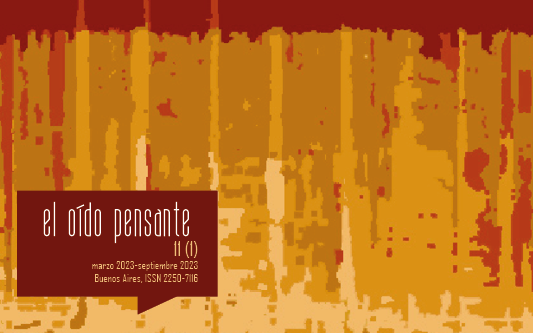“I Just Go with What Feels Right”. Variance and Commonality in Metal Music Mixing Practice
Abstract
Metal music is a genre defined by transgression, usually with the musical pursuit of heaviness. Interestingly, this commonly accepted genre-defining criterion, which can be considered as involving progress, conflicts with recent suggestions that the production of metal music is becoming more and more standardized, potentially hindering metal music’s musical evolution. Based on interviews with eight leading metal producers, this study investigates the professionals’ mixing approaches to determine whether they match the presumed standardization. The study finds common mixing approaches that result from the technical requirements of engineering fast, complex, and sonically dense music. However, there are significant alternatives between which producers choose to achieve the desired aesthetic outcomes. A multifaceted genre like metal with its diverse subgenres requires more than one production approach, and the unique combination and nuanced implementation of these approaches facilitate original results. With this in mind, the various production approaches, processes, and techniques appear to be evolving alongside the sub-genres and musical styles, supporting the genre’s quest for transgression and heaviness.Downloads
References
Anthony, B. (2017). A Final Guiding Hand: A Practice-Based Study into the Evolving Role of Third Party Mixers. IASPM Journal, 7(2), 41-47. Doi: 10.5429/2079-3871(2017)v7i2.7en
Auvinen, T. (2017). A New Breed of Home Studio Producer? Agency and the Idea ‘Tracker’ In Contemporary Home Studio Music Production. Journal on the Art of Record Produc-tion, 11. Retrieved from https://www.arpjournal.com/asarpwp/a-new-breed-of-home-studio-producer-agency-and-the-idea-tracker-in-contemporary-home-studio-music-production
Bennett, S. (2019). Modern Records, Maverick Methods. London: Bloomsbury.
Berger, H., and Fales, C. (2005). Heaviness in the Perception of Heavy Metal Guitar Timbres: The Match of Perceptual and Acoustic Features over Time. In P. Greene and T. Porcello (Eds.). Wired for Sound (pp. 181-197). Middletown: Wesleyan University Press.
Creswell, J. (2013). Qualitative Inquiry and Research Design: Choosing among Five Ap-proaches. London: SAGE.
Dale, P. (2016). Popular Music and the Politics of Novelty. London: Bloomsbury.
Deeks, M. (2016). National Identity in Northern and Eastern European Heavy Metal (doctoral thesis). University of Leeds, Leeds, UK.
Filho, J. C. (2010). From Performance to Recording: Assumptions of the Aesthetics of Rock Debate. E-Compós, 13(2), Doi: 10.30962/ec.491.
Flick, U. (2010). An Introduction to Qualitative Research. London: SAGE.
Herbst, J.-P. (2017a). Historical Development, Sound Aesthetics and Production Techniques of the Distorted Electric Guitar in Metal Music. Metal Music Studies, 3(1), 24-46. Doi: 10.1386/mms.3.1.23_1
Herbst, J.-P. (2017b). Shredding, Tapping and Sweeping: Effects of Guitar Distortion on Playability and Expressiveness in Rock and Metal Solos. Metal Music Studies, 3(2), 231-250. Doi: 10.1386/mms.3.2.231_1
Herbst, J.-P. (2019). The Formation of the West German Power Metal Scene and the Ques-tion of a ‘Teutonic’ Sound. Metal Music Studies, 5(2), 201-223. Doi: 10.1386/mms.5.2.201_1
Herbst, J.-P. (2020). From Bach to Helloween. ‘Teutonic’ Stereotypes in the History of Popu-lar Music. Metal Music Studies, 6(1), 87-108. Doi: 10.1386/mms_00006_1
Herbst, J.-P. and Bauerfeind, K. (2021). Teutonic Metal: Effects of Place- and Mythology-based Labels on Record Production. International Journal of the Sociology of Leisure, 4, 291-313. Doi: 10.1007/s41978-021-00084-5
Herbst, J.-P. and Mynett, M. (2021a). Nail the Mix: Standardization in Mixing Metal Music?. Popular Music and Society, 44(5), 628-649. Doi: 10.1080/03007766.2021.1957544
Herbst, J.-P. and Mynett, M. (2021b). (No?) Adventures in Recording Land: Engineering Conventions in Metal Music. Rock Music Studies. Doi: 10.1080/19401159.2021.1936410
Herbst, J.-P. and Mynett, M. (2022a). Towards a Systematic Understanding of “Heaviness” in Metal Music Production. Rock Music Studies, 10(1), 16-37. Doi: 10.1080/19401159.2022.2109358
Herbst, J.-P. and Mynett, M. (2022b). What is “Heavy” in Metal? A Netnographic Analysis of Online Forums for Metal Musicians and Producers. Popular Music and Society, 45(5), 633-653. Doi: 10.1080/03007766.2022.2114155
Herbst, J.-P. and Mynett, M. (2023). Mapping the Origins of Heaviness between 1970-1995: A Historical Overview of Metal Music Production. In J.-P. Herbst (Ed.). The Cambridge Companion to Metal Music. Cambridge: Cambridge University Press (forthcoming).
Izhaki, R. (2013). Mixing Audio. London: Focal Press.
Kahn-Harris, K. (2007). Extreme Metal. Oxford: Berg.
Keightley, K. (2001). Reconsidering Rock. In S. Frith, W. Straw and J. Street (Eds.). The Cambridge Companion to Pop and Rock (pp. 109-142). Cambridge: Cambridge Universi-ty Press.
Krotz, A. and Hodgson, J. (2019). Mixing for Markets. In R. Hepworth-Sawyer and J. Hodg-son (Eds.). Mixing Music (pp. 140-152). London: Routledge.
Marrington, M. (2019). The DAW, Electronic Music Aesthetics, and Genre Transgression in Music Production: The Case of Heavy Metal Music. In R. Hepworth-Sawyer (Ed.), Pro-ducing Music (pp. 52-74). London: Routledge.
Martin, A. (2015). The Role and Working Practice of Music Producers (doctoral thesis). Uni-versity of Hull, Hull, UK.
Moore, A. (2019). Tracking with Processing and Coloring as You Go. In R. Hepworth-Sawyer (Ed.). Producing Music (pp. 209-226). London: Routledge.
Moylan, W. (2002). The Art of Recording. Amsterdam: Focal Press.
Mynett, M. (2016). The Distortion Paradox: Analyzing Contemporary Metal Production. In A. Brown, K. Spracklen, K. Kahn-Harris and N. Scott (Eds.). Global Metal Music and Culture (pp. 68-88). London: Routledge.
Mynett, M. (2017). Metal Music Manual: Producing, Engineering, Mixing, and Mastering Contemporary Heavy Music. London: Routledge.
Mynett, M. (2019a). Defining Contemporary Metal Music: Performance, Sounds and Practic-es. Metal Music Studies, 5(3), 297-313. Doi: 10.1386/mms.5.3.297_1
Mynett, M. (2019b). Heaviness in Three Dimensions: The Use of Sonic Space in Contempo-rary Metal Music Production. In S. Zagorski-Thomas, K. Isakoff, S. Stévance and S. Lacasse (Eds.), Art of Record Production: Creative Practice in the Studio (pp. 66-79). London: Routledge.
Mynett, M. (2020). Maximum Sonic Impact: (Authenticity/Commerciality) Fidelity-Dualism in Contemporary Metal Music Production. In S. Zagorski-Thomas and A. Bourbon (Eds.). The Bloomsbury Handbook of Music Production (pp. 293-302). London: Blooms-bury.
North, M. (2013). Novelty: A History of the New. Chicago: University of Chicago Press.
Reynolds, S. (2011). Retromania: Pop Culture’s Addiction to its Own Past. London: Faber and Faber.
Savage, S. (2014). Mixing and Mastering in the Box. Oxford: Oxford University Press.
Schmidt-Horning, S. (2013). Chasing Sound. Baltimore: Johns Hopkins University Press.
Thomas, N. (2015). The Development of Technology and its Influence on Recorded Heavy Metal Music 1969-2015 (Ph.D. thesis). University of Hull, Hull, UK.
Thomas, N. and King, A. (2019). Production Perspectives of Heavy Metal Record Producers. Popular Music, 38(3), 498-517. Doi: 10.1017/S026114301900031X
Turner, D. (2009). Outlining the Fundamental Production Aesthetics of Commercial Heavy Metal Music Utilising Systematic Empirical Analysis. Art of Record Production Confer-ence. Retrieved from https://www.artofrecordproduction.com/aorpjoom/symposiums/21-arp-2009/117-turner-2009
Wallach, J., Berger, H. and Greene, P. (2011). Affective Overdrive, Scene Dynamics, and Identity in the Global Metal Scene. In H. Berger, J. Wallach and P. Greene (Eds.). Metal Rules the Globe (pp. 3-33). Durham: Duke University Press.
Wallmark, Z. (2018). The Sound of Evil: Timbre, Body, and Sacred Violence in Death Metal. In R. Fink, M. Latour and Z. Wallmark (Eds.). The Relentless Pursuit of Tone (pp. 65-87). Oxford: Oxford University Press.
Walser, R. (1993). Running with the Devil. Hanover: Wesleyan University Press.
Zak, A. (2001). The Poetics of Rock. Berkeley: University of California Press.























